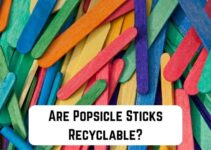Often a common sight at parties nowadays, meat trays, also called party trays, are becoming increasingly popular as appetizers. Just as the name implies, a meat tray is an arrangement of different types, slices or cuts of meat. However, for more efficacy, you can garnish it with an array of cheeses or even fruits.
Once those parties are over, and your meat trays are no longer looking presentable, or you don’t have any use for them anymore, you begin to wonder what to do with them.
Do these holders of delicious snacks go in the bin right after use? Will you keep them for the next party? Can you recycle meat trays, and are they safe for the environment? These are questions that you and a host of others are curious about due to the increasing popularity of meat trays.
So, to enable you to make environmentally friendly decisions when next you have a party, we’ll discuss whether or not meat trays are recyclable, as well as their effects on the environment.
Dive right in!
Can You Recycle Meat Trays?
It’s not uncommon to decide to reuse your meat trays for other events and purposes. After all, they are quite durable and functional. But, of course, there are a host of other functions they can perform too.
However, what you decide to do with them, in the long run, will ultimately be determined by whether or not they’re recyclable. So, do you throw them away? Let’s find out.
Meat trays are mostly made from three major materials, and that’s what determines their recyclability. These include Polystyrene, commonly known as Styrofoam, an absorbent pad, and clear plastic wrap.
The tray made from Polystrene is recyclable. However, most recycling facilities won’t be accepting it due to food contamination. You can take them to your local recycling center to recycle them there.
The absorbent pad is mostly made from silica gel and is usually not recycled. You have to dispose of it in the trash.
Unfortunately, you can’t put plastic wrap film in the curbside bin as it may jam sorting machinery at the recycling factory.
Are Plastic Meat Trays Recyclable?
We know you’re trying to look out for your environment by not polluting landfills with your plastic meat trays. So, let’s tell you all you need to know when you want to recycle them.
Plastic meat trays are often soft, and as such, are ideal for packing products such as meat, sausages etc. This is what makes them easy to recycle. However, even though plastic meat trays are recyclable, you must take certain precautions when recycling them. First, you must determine the type of material you are handling.
Plastic meat trays, for example, are made from transparent material that is not very rigid. To effectively identify easily recyclable plastic meat trays, always look for those with Resin Identification Code of 1, 2, 3 and 5. These codes help you identify whether the plastic is PET, HDPE, UPVC or PP.
You must, therefore, ensure you do not mix this type of plastic with other types. Meaning, do not mix hard and soft plastics. This is to ensure that all the waste content in one recycle bin are of the same material.
It can also help to try and get enough information on how to dispose of these plastics before proceeding to recycle them. For example, different plastics have symbol-like instructions below them that show how we should dispose of them.
This can point you in the right direction and will save you from recycling materials that we should never recycle together.
Finally, before disposing of your plastic meat trays, it’s best to wash them. This is because these plastic meat trays are often recycled to make the same packaging.
Hence, they should be free of any form of dirt or any unpleasant substances to prevent them from posing a health risk to consumers after they’re recycled to form a new package.
Your soon-to-be recycled plastic meat trays must be free of any greasy or oily substance as it can otherwise affect the quality of the new packaging product being manufactured.
Are Styrofoam Meat Trays Recyclable?
You’ve probably tried disposing of your styrofoam meat trays and wondered why there aren’t many recycling centers taking them. Well, we’re here to satisfy your curiosity.
Meat trays made from Styrofoam (also known as polystyrene) are very common, especially in supermarkets worldwide. You’ve probably also seen them used as disposable cutlery, coffee cups, trays, egg cartons, etc.
Styrofoam is a synthetic hydrocarbon polymer used to form insulation for the products we’ve just mentioned above.
Styrofoam is very stiff but very versatile. Our meat trays are made from EPS (expanded polystyrene), which is expanded polystyrene – the process of expanding polystyrene cells. This makes them lighter, thinner and more brittle.
This material is a number 6 plastic, and processing it requires heavy machinery that most recycling companies don’t have. This is why it’s not widely recycled as it’s not as simple as just sorting it into the nearest recycle bin.
Styrofoam is also not biodegradable, but when it breaks down, it becomes toxic and leaves an alarming effect on the environment.
To recycle EPS, it must first be condensed with a condensing machine. This is essentially shredding and breaking into tiny pieces.
These pieces will then be gathered and compressed into logs, then be used to produce other products such as construction materials or ceiling molding. Recyclers can also transform it into surfboards, jewelry cases, pots or picture frames.
The problem with recycling EPS is sorting it because it easily breaks into very tiny pieces that become difficult to gather. In addition, we cannot be put into EPS recycling bins like plastics because it goes through very different recycling processes.
Are Meat Trays Biodegradable?
We have clarified the basic knowledge that meat trays are either produced from plastics and polystyrene. Another important thing you should note is what it means when a product is biodegradable.
Biodegradable products can be broken down by microorganisms and bacteria in the soil without polluting the environment in any way.
So, are meat trays biodegradable? Polystyrene meat trays are not biodegradable. They are produced when styrene is combined with pentane; this process involves the use of various chemicals.
These chemicals are not environmental-friendly, so when you try to biodegrade them, they end up polluting the environment because bacteria have a difficult time breaking them down.
On the other hand, plastic meat trays are biodegradable. They can be broken down into carbon dioxide, water, and biomass by bacteria and other organisms in the soil. Plastic meat trays are usually produced from recycled raw materials and petrochemicals.
Are Meat Trays Bad for the Environment?
We’ve all become environmentally conscious, and sustainability concerns make us interested in what’s best for our environment. So, one question on your mind every time you want to dispose of your meat trays is if they are good or bad for the environment that you love so much.
Meat trays are bad for the environment because the materials from which they are made are harmful if we don’t dispose of them properly. They take years to decompose and are non-biodegradable.
Plastic meat trays are harmful if not disposed of properly. They’re non-biodegradable because of their high durability, which makes them an uncommon target for bacteria.
Plastic is also one of the major causes of water pollution, which can lead to the death of wildlife as there is currently an alarming level of plastic debris floating in the world’s seas.
This has led to the death of thousands of aquatic creatures over the years as they ingest these plastics mistaking them for food, which can lead to slow poisoning from chemicals leached or attached to the plastics, malnutrition or even intestinal blockage and ultimately, death.
Often, people try to dispose of their plastic meat trays by burning them. Little do they know they are causing more harm than good to the environment. The burning of plastics releases dioxins and other harmful chemicals like greenhouse gases into the atmosphere, posing health risks such as cancer to humanity and wildlife.
There have also been signs of impending global warming, which can put the whole of civilization in danger. These dioxins can also get deposited on our soil and plants – their negative effect is all-encompassing.
Styrofoam is equally as harmful to the environment as it’s a petrochemical and is also non-biodegradable. It takes over 500 years to decompose and fills up space indefinitely when dumped in landfills. In the process, it releases harmful chemicals into the environment.
Styrofoam can be a health hazard to those who live in areas with a lot of them. They can lead to health problems such as cancer, depression, etc. It can also get in the oceans and release harmful chemicals that can kill sea animals.
Polystyrene can also evaporate into the air and release harmful elements that lead to the depletion of the ozone layer.
It’s, however, common knowledge that recycling is a good way of protecting the environment. Therefore, recycling plastics and Styrofoam is an excellent way to prevent the emission of many greenhouse gases and other harmful substances.
It also helps save fast diminishing landfill space and also generally promotes environmental conservation.
So, we urge you to have a rethink while disposing of your styrofoam meat trays next time.
What Can You Do with Plastic Meat Trays?
Recycling is a great way to protect your environment. But there is another option that you can explore before deciding to dispose of your plastic meat trays, and you can maximize this option in your quest to protect the environment. This involves reusing or repurposing the plastic meat trays.
1. Organizational Tools
Reusing plastic meat trays involves using them as organization tools within the home. For example, you can use them to keep medications and vitamins away from children.
They’re also excellent for organizing little toys, pet supplies, stationery, office supplies, garden tools, kitchen utensils, and keeping toiletries organized in a bag or suitcase.
2. Food and Water Storage
You can use meat trays as an alternative means of storing edibles. You can also keep water in them for refrigeration; this is great, especially during the summer. For leftover foods, you can also use meat trays to store vegetables and desserts in the refrigerator for future use.
3. Arts and Crafts
Plastic meat trays are soft and flexible, so you can cut them into patterns you can reconstruct for arts and crafts. If you have kids, we’re certain you can use your old meat trays to keep them entertained in all forms of ways.
Conclusion
When you buy and use meat trays, you may not immediately consider their environmental effects. But now that you are aware and we have established that meat trays are recyclable, using them and properly disposing of them after your next party or event should not be a problem.
However, it is important to take the precautions listed before recycling meat trays made of either polystyrene or plastics to ensure environmental sustainability.






